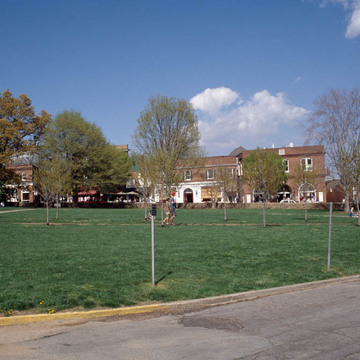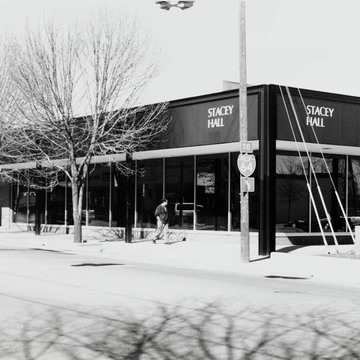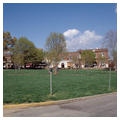“The Corner,” or the area where present-day U.S. Business 250, or West Main Street, turns into University Avenue, was very early a commercial center for the university community. The road has always been a major east-west highway. James Dinsmore, one of Jefferson's builders, was one of its first developers. Along the north side at The Corner stands Saint Paul's Episcopal Church (1925–1927, Eugene Bradbury), 1700 University Avenue), whose giant portico rather pompously relates to Jefferson and White across the street. Bradbury submitted a more humble design loosely based on Bruton Parish Church in Williamsburg, with a small entrance tower, but Saint Paul's vestry demanded grandeur. The luminous box of the interior recalls the work of Charles Bulfinch. Farther east, the Anderson Brothers' Bookstore (1891, J. K. Mesker Co. of St. Louis), 1419 University Avenue, with its pressed metal facade, is the most distinguished commercial building. Several blocks to the east is the University Baptist Church (1928, Herbert Levi Cain),
Back to the west and across from the Corner, on the south side stand the Senff Entrance Gates (1914–1915, Henry Bacon), by the designer of the Lincoln Memorial, which provide a terminus to West Main Street. Although such gating and enclosing fencing was a common collegiate feature of those years, Bacon's gates indicate a continuing problem with entrance to the university. To the south of the gates (and east of the Jefferson precinct) lies the Health Sciences or Medical School–Hospital Center, a vast, labyrinthine maze created by many building campaigns and architects. Notable buildings include the Entrance Building (1912–1914, Eugene Bradbury), in, of course, a very refined colonial-Jeffersonian idiom. But the dominant element is the Medical School Building (1929, Coolidge, Shepley, Bulfinch and Abbott), its vast portico entrance looming over everything. The original hospital wing (1899–1901, Paul J. Pelz and many others) is around the corner to the west, but it is hidden by later additions. Behind this giant complex is an even larger one to the east, on Lee Street, visible from all over town, the high-rise University Hospital (1987–1991, Metcalf, Davis, Brody and Partners with Russo and Sonder; later additions) and associated buildings. The main hospital building, with its simple form and sleek skin of white enamel panels and glazing, resembling minimalist sculpture, is an alien intruder from New York.








